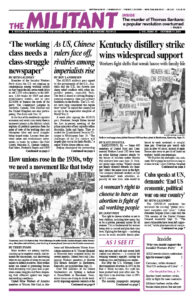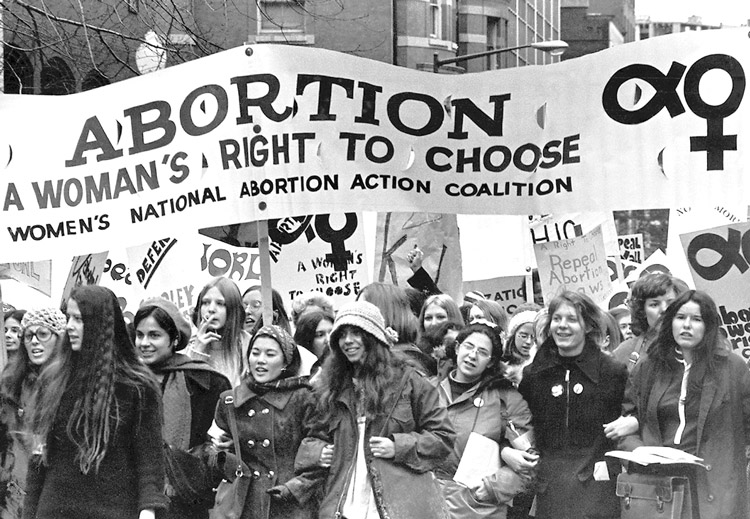The right to choose whether or not to bear children, including how many, has to be a private, personal matter for all women. This is fundamental for women being able to control and plan their own lives. Fighting for that right — including access to easily available family planning services and safe and secure birth control and abortion — is essential for winning women’s equality, uniting the working class and building our unions.
But after the U.S. Supreme Court decriminalized abortion in 1973 in the Roe v. Wade decision, this right has been pushed back year after year. Today there is no abortion clinic in 90% of U.S. counties.
The nonstop propaganda campaign and erosion of women’s right to choose has had an impact on the consciousness of working people. Millions are convinced that life begins at conception or soon after, even if they do not support restricting all abortions. This has occurred in the absence of any answer from the union movement clearly explaining that winning support for the right to choose is a working-class issue. This is a political debate within the working class that must be taken on.
The latest attack is the Texas “heartbeat” law, which prohibits abortion after “cardiac activity” is detected, usually after six weeks of pregnancy. It went into effect Sept. 1. Three months later the Supreme Court will hear the state of Mississippi’s appeal of lower court decisions that ruled its 2018 law that outlawed abortion after 15 weeks unconstitutional.
After World War II growing numbers of women entered the workforce and solidarity between working men and women grew. More women got jobs in what were traditionally men-only positions.
Standing on the shoulders of the fight for Black rights, which overthrew Jim Crow segregation and inspired the mass movement against the U.S. war on Vietnam, thousands of women began organizing to advance the fight for women’s rights, including the right to choose abortion.
But when the Supreme Court decriminalized abortion the debate on the right of a woman to control her own body had not been fought out and decisively won. Unlike the fight for Black rights, which involved millions of people over more than a decade, the women’s movement was just beginning.
The year after Roe v. Wade, leaders of middle-class women’s groups argued the battle had been won and further action would just rile up the right wing.
A flawed, premature decision
Not only was the court decision premature, the decision itself “was based not on a woman’s right ‘to equal protection of the laws’ guaranteed by the Fourteenth Amendment to the Constitution, but on medical criteria instead,” wrote Jack Barnes, national secretary of the Socialist Workers Party, in The Clintons’ Anti-Working-Class Record: Why Washington Fears Working People.
“During the first three months (‘trimester’), the court ruled, the decision to terminate a pregnancy ‘must be left to the medical judgment of a pregnant woman’s attending physician’ (not to the woman herself, but to a doctor!). At the same time, the court allowed state governments to ban most abortions after ‘viability,’” Barnes said, “something that medical advances inevitably make earlier and earlier in the pregnancy.”
Opponents of women’s rights try to convince working people that abortion is murder. That’s why the Texas law is called “fetal heartbeat” — with no basis in science. An embryo at six weeks does not have anything resembling a human heart.
When abortion was illegal hundreds of women died in the U.S. from unsanitary abortions every year. In 1965 17% of all maternal deaths occurred because of botched abortions. The deadly consequences fell overwhelmingly on working-class women, who were far less able to pay for safe procedures.
Like men, women must have the right to make their own decisions about their own bodies, including all medical decisions. Fighting for this is a precondition to winning women’s full emancipation.
Instead of educating and mobilizing to win a majority to defend the right to choose, organizations like the National Organization for Women and the National Abortion Rights Action League have for decades urged women not to rock the boat and to rely on Democratic Party officials. This course has been a disaster.
What is needed is to clearly answer the arguments that opponents of women’s rights use, and to mobilize in the streets to win a decisive majority among working people. Our unions should be at the forefront of this fight.
Without a fight for women’s equality, the solidarity the working class needs to fight the bosses, and to wage a revolutionary struggle to take political power out of the hands of the capitalist class, is impossible. Without the right to decide when or whether to bear a child, women cannot participate as equals in economic or political life.


